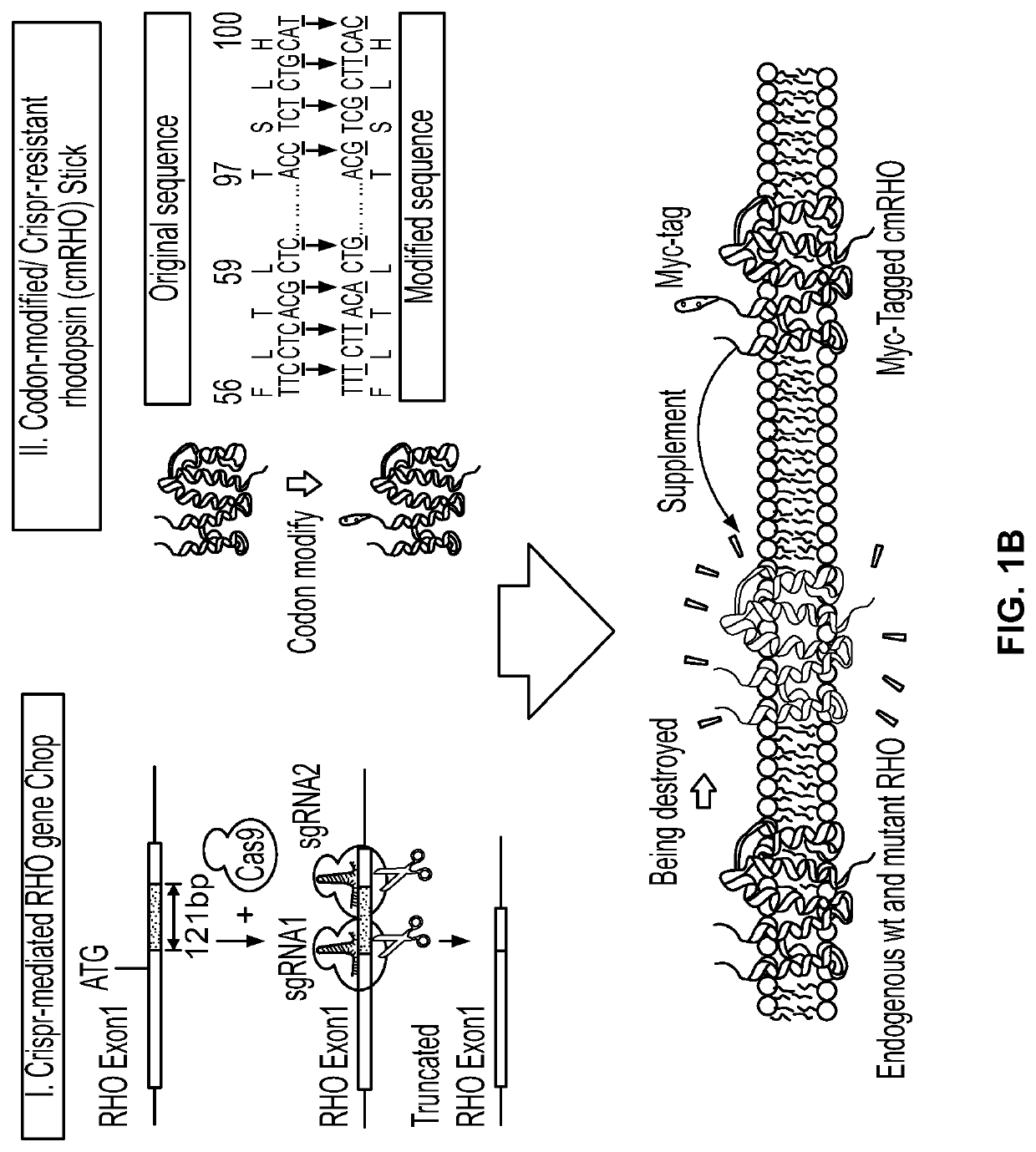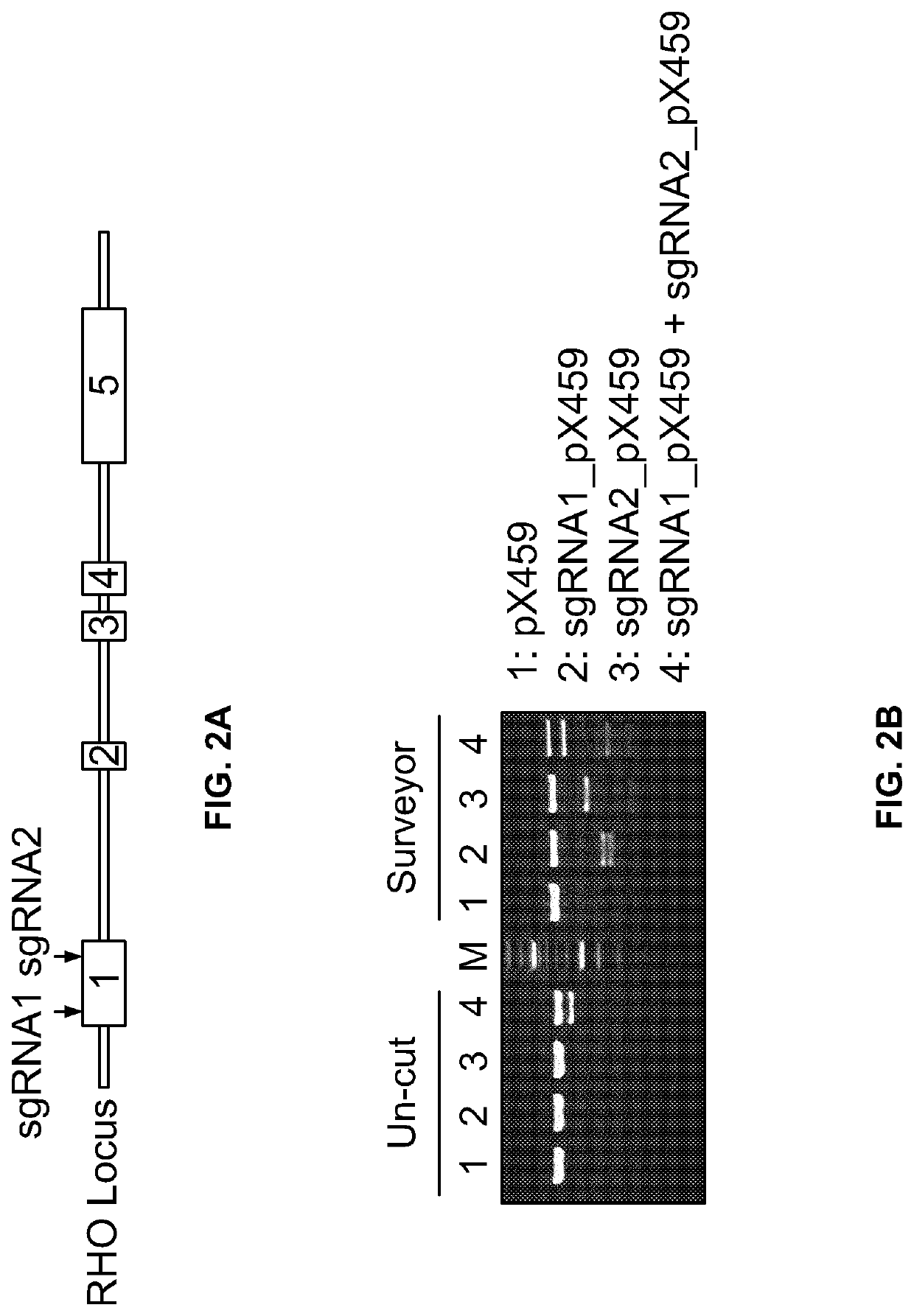Gene Editing for Autosomal Dominant Diseases
a technology gene editing, applied in the field of gene editing for autosomal dominant diseases, can solve the problems of no cure for numerous autosomal dominant or recessive diseases that have a profoundly negative impact on quality of life, no cure for rp, and diseases that are not readily amenable,
- Summary
- Abstract
- Description
- Claims
- Application Information
AI Technical Summary
Benefits of technology
Problems solved by technology
Method used
Image
Examples
example 1
AAV Gene Therapy Strategy Evaluation
[0329]The present Example outlines the strategy behind ChopStick AAV gene therapy. The ChopStick Strategy is also referred to herein as CRISPR 2.0. The approach is based on using a gene-editing enzyme with one or more unique single guide RNA (sgRNA) sequences that target both mutant and wild type forms of rhodopsin for destruction. This initial step is then followed by supplying a wild-type codon modified rhodopsin cDNA to the cells. A significant advantage of this system is that the codon modified rhodopsin cDNA is not recognizable by the sgRNA(s) and thus is resistant to the cleavage by the nuclease.
[0330]As shown in FIG. 1, the “ChopStick” system described here is packaged into two recombinant AAV vectors (FIG. 1A). The first vector carries the polynucleotide sequence encoding the Cas9 enzyme (SEQ ID NO: 17), which is able to “chop” the mutant and native rhodopsin genes, while the second vector contains a polynucleotide encoding the codon-modif...
example 2
s9-Induced Gene Editing in a Mouse Model of Retinitis Pigmentosa Delays Disease Progression
[0334]Next, the inventors verified the feasibility and efficacy of the CRISPR / Cas9 endonuclease system as a gene-editing treatment modality in a mouse model of RP with the dominant D190N rhodopsin mutation. In these experiments, two AAV8 vectors containing the Cas9 coding sequence and the sgRNA (SEQ ID NO: 4) / donor template marked with an AflII restriction site were used. Insertion of AflII restriction site allows for the identification of cells that have undergone homologous recombination (FIGS. 4A-4C). Briefly, heterozygous RhoD190N / + was transduced into the right eye before post-natal day 5 with above described recombinant AAV8 vectors. The sgRNA targeting frequency and recombination of donor template (SEQ ID #23) were verified by TIDE indel tracking tool (Brinkman et al. Nucleic Acid Res. 2014 Dec. 16, 42(22): e168) and AflII enzyme digestion (FIG. 4). About 50% of cells underwent NHEJ (mo...
example 3
diated Humanized Exon 1 at the Mouse Rho Locus
[0335]The inventors of the present disclosure next tested the ability to replace mouse Rho locus with wild-type (wt) (SEQ ID NO: 24) or mutant human (h) (SEQ ID NO: 25) RHO exon 1 in mouse embryonic stem (ES) cells (FIG. 6). Briefly, ES cells were co-transfected (via electroporation) with the Cas9 expression vector carrying a Rho exon 1-specific sgRNA (sgRNA-Rho Exon 1, SEQ ID NO: 5) targeting mouse Rho exon 1) and a targeting vector carrying with human RHO donor template, which contained a sequence of hRHO exon 1 flanked with ˜750 bp homologous arm on each side (FIG. 6A). Human RHO donor template is expected to replace mouse exon 1 and confer resistance to sgRNA-Rho Exon 1. Seven days after electroporation, ES clones were picked and DNA was extracted and amplified with screening primers. Two out of 96 clones were detected with replacement of human exon 1 by RFLP analysis (FIG. 6B). As shown in FIG. 6C, sequence electropherograms of ampl...
PUM
| Property | Measurement | Unit |
|---|---|---|
| diameter | aaaaa | aaaaa |
| diameter | aaaaa | aaaaa |
| size | aaaaa | aaaaa |
Abstract
Description
Claims
Application Information
 Login to View More
Login to View More - R&D
- Intellectual Property
- Life Sciences
- Materials
- Tech Scout
- Unparalleled Data Quality
- Higher Quality Content
- 60% Fewer Hallucinations
Browse by: Latest US Patents, China's latest patents, Technical Efficacy Thesaurus, Application Domain, Technology Topic, Popular Technical Reports.
© 2025 PatSnap. All rights reserved.Legal|Privacy policy|Modern Slavery Act Transparency Statement|Sitemap|About US| Contact US: help@patsnap.com



